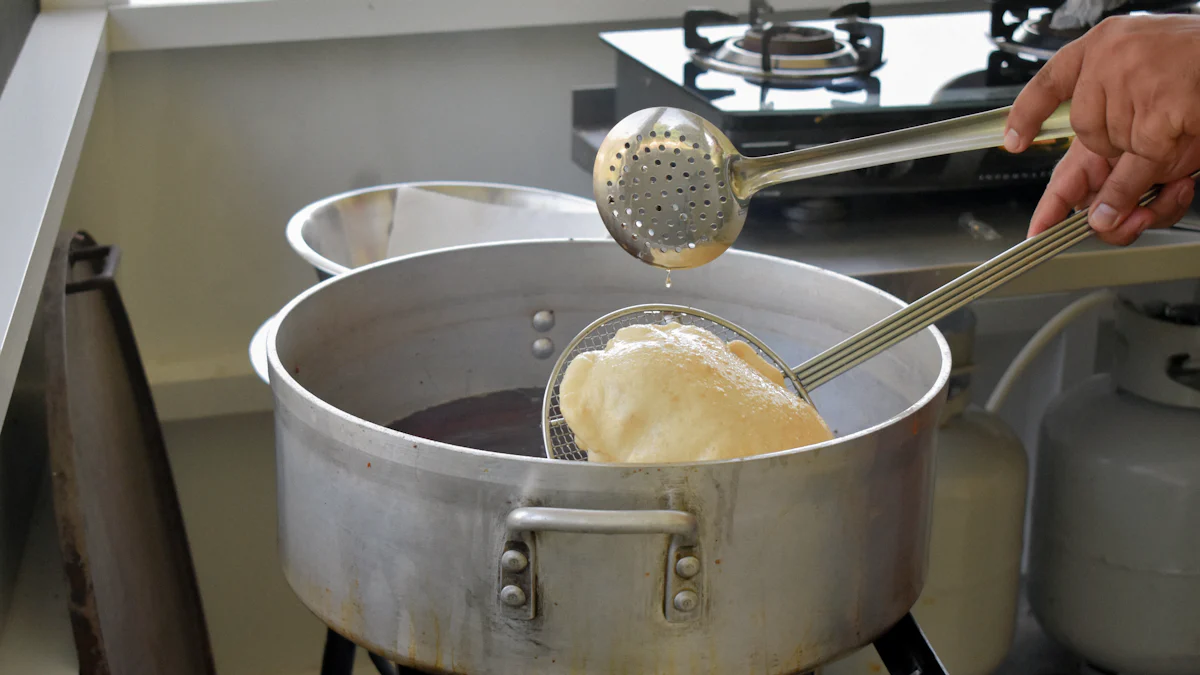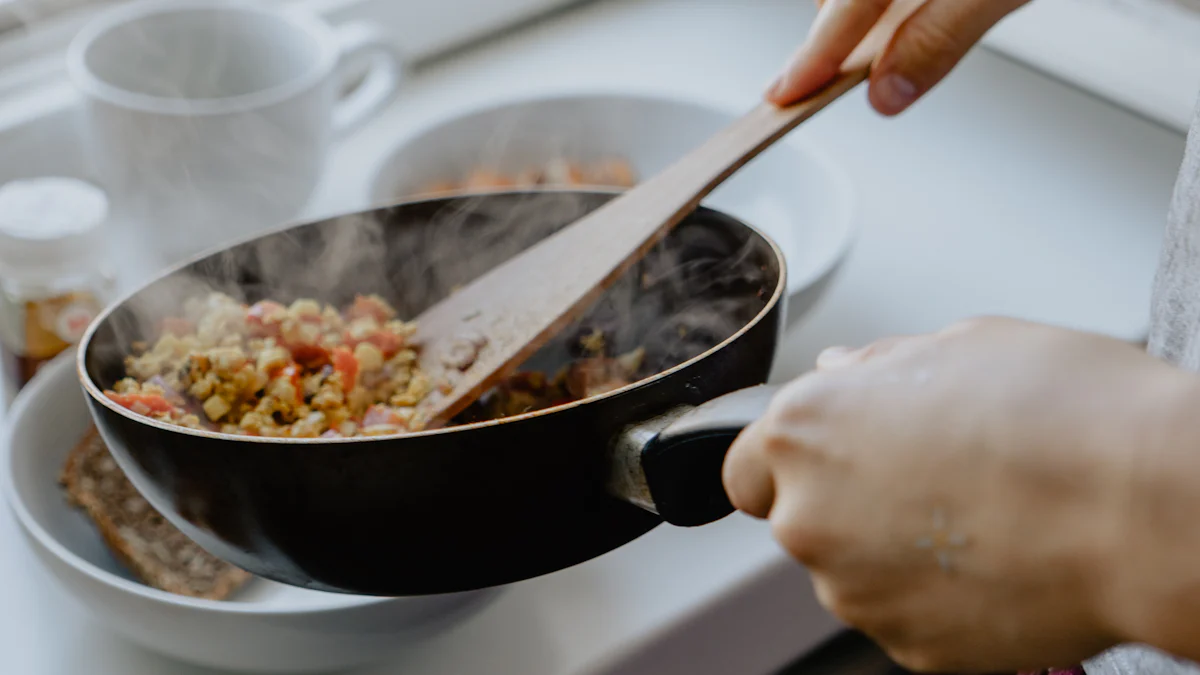Key Takeaways
- Using a scratched nonstick pan can release harmful chemicals and microplastics into food, posing serious health risks.
- Replace any nonstick pan that shows deep scratches, peeling, or was manufactured before 2013 to minimize exposure to toxic substances.
- Minor scratches may be manageable at low temperatures, but regular inspection of cookware is essential for safety.
- Consider repairing minor scratches with specialized nonstick repair sprays, but be aware that deep damage requires replacement.
- Explore safer alternatives to nonstick pans, such as stainless steel, cast iron, or ceramic-coated cookware, for healthier cooking options.
- Adopt proper care techniques, like using non-abrasive cleaning tools and safe cooking practices, to extend the life of your nonstick pans.
- Prioritize health by replacing damaged cookware promptly to ensure a safe and enjoyable cooking experience.
What Are the Health Risks of Using a Scratched Nonstick Pan?

Cooking with a scratched nonstick pan can introduce several health risks. Damage to the coating compromises its integrity, allowing harmful substances to leach into food. Understanding these risks is essential for making informed decisions about cookware safety.
Release of Harmful Chemicals
Scratches on a nonstick pan can expose the underlying layers of the coating. Many older nonstick pans contain per- and polyfluoroalkyl substances (PFAS), which are linked to serious health concerns. Studies have shown that PFAS exposure may contribute to liver damage, reduced immune function in children, and even certain cancers, such as kidney and testicular cancers. When the surface of a pan is damaged, these chemicals can migrate into food, especially at high temperatures.
Scientific Research Findings: Research on Teflon-coated cookware revealed that pans made with PFOA, a type of PFAS, posed significant health risks. Although newer nonstick pans use alternative PFAS, similar concerns persist regarding their safety.
To minimize exposure, it is crucial to avoid using scratched non-stick pans, particularly those manufactured before 2013. These older pans often contain outdated and more hazardous chemical formulations.
Ingestion of Coating Particles
A scratched nonstick pan can shed tiny particles of its coating into food. A recent study quantified the release of millions of microplastic particles from a single scratch on a frying pan. These particles, though small, may accumulate in the body over time, potentially leading to unknown long-term effects.
Scientific Research Findings: A study highlighted the risks of ingesting microplastics from damaged cookware. While the immediate health impact remains unclear, experts recommend replacing pans with significant scratches to avoid unnecessary exposure.
Ingesting these particles not only raises health concerns but also affects the quality of meals. Food cooked in a heavily scratched pan may stick to the surface, reducing the effectiveness of the nonstick coating.
When Should You Stop Using a Scratched Nonstick Pan?
Determining when to stop using a scratched nonstick pan depends on the extent of the damage. Minor surface scratches may not pose immediate risks if the pan is used at low temperatures. However, deep scratches or peeling coatings signal the need for replacement. Peeling indicates that the protective layer has deteriorated, increasing the likelihood of chemical leaching and particle ingestion.
Experts advise replacing any nonstick pan that shows visible signs of wear, especially if it is older or frequently used. Regularly inspecting cookware for damage ensures safer cooking practices and reduces potential health risks.
Repair or Replace: What Should You Do With a Scratched Nonstick Pan?
Deciding whether to repair or replace a scratched nonstick pan depends on the severity of the damage and the pan’s overall condition. Understanding the options available can help ensure safe cooking practices and extend the life of your cookware.
Can Scratched Nonstick Pans Be Repaired?
Repairing a scratched nonstick pan is possible in some cases, but it requires careful attention to detail. Minor scratches can often be addressed using specialized nonstick repair sprays. These sprays are designed to reseal the damaged coating, restoring its nonstick properties.
To repair a pan:
- Clean the pan thoroughly to remove any food residue or grease.
- Apply several layers of nonstick repair spray evenly across the surface.
- If the pan is oven-safe, bake it at 500°F for 40 to 45 minutes to seal the coating.
This process can temporarily restore the pan’s functionality. However, it is essential to note that repaired pans may not perform as effectively as new ones. Deep scratches or peeling coatings cannot be fully repaired and may still pose health risks. In such cases, replacement is the safer option.
Tip: Always follow the manufacturer’s instructions when using repair sprays to ensure proper application and safety.
When Should You Replace Your Nonstick Pan?
Replacing a nonstick pan becomes necessary when the damage compromises its safety and performance. Visible signs such as deep scratches, flaking, or peeling coatings indicate that the pan is no longer suitable for use. These issues increase the risk of harmful chemicals leaching into food and reduce the pan’s effectiveness.
Experts recommend replacing pans that:
- Have significant scratches or peeling coatings.
- Were manufactured before 2013, as older pans may contain outdated and potentially hazardous materials.
- No longer provide a smooth, nonstick surface, causing food to stick during cooking.
Investing in high-quality replacements from reputable brands ensures better durability and safety. Proper maintenance of new cookware can also prevent future damage and extend its lifespan.
Alternatives to Nonstick Pans
For those seeking safer and more durable options, alternatives to traditional nonstick pans are worth considering. These alternatives offer excellent cooking performance without the risks associated with scratched coatings.
- Stainless Steel Cookware: Durable and versatile, stainless steel pans are ideal for browning and searing. They require proper seasoning to achieve a nonstick effect.
- Cast Iron Pans: Known for their longevity, cast iron pans develop a natural nonstick surface over time with regular seasoning. They are suitable for high-heat cooking and retain heat well.
- Ceramic-Coated Pans: Ceramic cookware provides a nonstick surface without the use of harmful chemicals. It is an eco-friendly option that performs well at moderate temperatures.
Pro Tip: When transitioning to alternative cookware, consider your cooking needs and preferences to select the best option for your kitchen.
Choosing the right solution—whether repairing, replacing, or switching to alternatives—ensures safer cooking and better meal quality. Regularly inspecting cookware and addressing damage promptly can help maintain a healthy cooking environment.
How to Prevent Scratches on Nonstick Pans

Proper care and maintenance can significantly extend the lifespan of a nonstick pan. By adopting effective cleaning, cooking, and storage practices, individuals can minimize scratches and preserve the pan’s nonstick surface.
Proper Cleaning Techniques
Cleaning plays a vital role in maintaining the integrity of a nonstick pan. Harsh scrubbing or abrasive cleaning tools can damage the coating, leading to scratches and reduced performance. To clean a nonstick pan effectively:
- Allow the pan to cool completely before washing. Sudden temperature changes can weaken the coating.
- Use warm water and a mild dish soap to remove food residue. A soft sponge or cloth works best for gentle cleaning.
- Avoid steel wool, scouring pads, or any abrasive materials that can scratch the surface.
- For stubborn stains, soak the pan in soapy water for a few minutes before wiping it clean.
Pro Tip: Handwashing is always preferable for nonstick cookware. Dishwashers may expose the pan to high heat and harsh detergents, which can degrade the coating over time.
Safe Cooking Practices
Cooking habits directly impact the durability of a nonstick pan. Certain practices can prevent scratches and maintain the pan’s functionality:
- Use utensils made of silicone, wood, or plastic. Metal utensils can easily scratch the nonstick surface.
- Cook at low to medium heat. High temperatures can weaken the coating and increase the risk of scratches.
- Avoid cutting or slicing food directly in the pan. This action can create deep scratches that compromise the coating.
- Preheat the pan only when necessary, and never leave it empty on a hot burner for extended periods.
Scientific Research Findings: Overheating nonstick cookware can release harmful fumes and weaken the coating, making it more susceptible to scratches. Maintaining moderate cooking temperatures ensures both safety and longevity.
Looking for Non-stick cookware, please contact Ningbo Xianghai Kitchenware co.,ltd.
Storage Tips
Proper storage prevents unnecessary wear and tear on nonstick pans. Stacking pans without protection can lead to scratches and dents. To store nonstick cookware safely:
- Place a soft cloth, paper towel, or pan protector between stacked pans to prevent direct contact.
- Store pans in a single layer whenever possible to avoid pressure on the coating.
- Hang pans on hooks if space allows, ensuring they do not touch other cookware.
Pro Tip: Organizing cookware in a dedicated cabinet or drawer reduces the risk of accidental damage during storage.
By following these preventive measures, individuals can maintain the quality and safety of their nonstick pans. Regular care not only extends the life of the cookware but also ensures a healthier cooking experience.
Using a scratched nonstick pan introduces potential health risks, especially when the coating peels or flakes. While minor scratches may not immediately compromise safety, heavily damaged pans should be replaced to avoid exposure to harmful chemicals or particles. Proper care, such as gentle cleaning and safe storage, can prevent scratches and prolong the pan’s usability. Investing in high-quality cookware ensures better performance and safety. When uncertain about a pan’s condition, prioritizing health by replacing it with a safer alternative is always a wise decision.
FAQ
Is it safe to use a scratched nonstick pan?
Using a scratched nonstick pan can pose health risks. Scratches may cause the coating to flake off, mixing with food. At high temperatures, the nonstick surface can break down and release harmful fumes. Experts recommend avoiding heavily scratched pans to minimize exposure to these risks.
Can scratched nonstick pans release toxic chemicals?
Yes, scratched nonstick pans can release toxic chemicals, especially if they were manufactured before 2013. Older pans often contain PFOA or PFOS, which are linked to serious health concerns. While newer coatings use alternative chemicals, their long-term safety is still under study. Deep scratches increase the likelihood of chemical leaching into food.
Are minor scratches on a nonstick pan dangerous?
Minor scratches may not pose immediate health risks if the pan is used at low to medium heat. However, frequent use of a scratched pan can worsen the damage over time. Regular inspection of cookware helps determine whether it remains safe for use.
How can I tell if my scratched nonstick pan needs replacement?
Replace a nonstick pan if it shows deep scratches, peeling, or flaking. These signs indicate that the coating has deteriorated, increasing the risk of harmful chemical exposure. Additionally, pans manufactured before 2013 should be replaced due to outdated and potentially hazardous materials.
Can I repair a scratched nonstick pan?
Repairing a scratched nonstick pan is possible for minor damage. Nonstick repair sprays can reseal the coating temporarily. However, this solution is not permanent and may not restore the pan’s original performance. Deep scratches or peeling coatings cannot be fully repaired, making replacement the safer option.
What are safer alternatives to nonstick pans?
Several alternatives to nonstick pans offer excellent cooking performance without the risks associated with scratched coatings:
- Stainless steel cookware: Durable and versatile, ideal for browning and searing.
- Cast iron pans: Long-lasting and naturally nonstick with proper seasoning.
- Ceramic-coated pans: Eco-friendly and free from harmful chemicals, suitable for moderate temperatures.
Choosing the right alternative depends on individual cooking needs and preferences.
How can I prevent scratches on my nonstick pan?
Prevent scratches by adopting proper care practices:
- Use silicone, wooden, or plastic utensils instead of metal ones.
- Avoid cutting or slicing food directly in the pan.
- Clean with a soft sponge and mild soap; avoid abrasive tools.
- Store pans with protective layers, such as cloth or paper towels, between them.
These habits help maintain the pan’s surface and extend its lifespan.
Is it safe to use old nonstick pans?
The safety of old nonstick pans depends on their condition and manufacturing date. Pans made before 2013 may contain harmful chemicals like PFOA. If an old pan shows signs of wear, such as scratches or peeling, it should be replaced to ensure safe cooking.
What happens if I ingest particles from a scratched nonstick pan?
Ingesting particles from a scratched nonstick pan may introduce microplastics into the body. While the immediate health effects remain unclear, experts advise replacing heavily scratched pans to avoid unnecessary exposure. Cooking with damaged pans also reduces meal quality, as food may stick to the surface.
Can overheating a nonstick pan cause damage?
Overheating a nonstick pan weakens the coating and increases the risk of scratches. It can also release harmful fumes, especially if the pan is damaged. Cooking at low to medium heat preserves the pan’s integrity and ensures safer use.
Post time: Jan-02-2025
